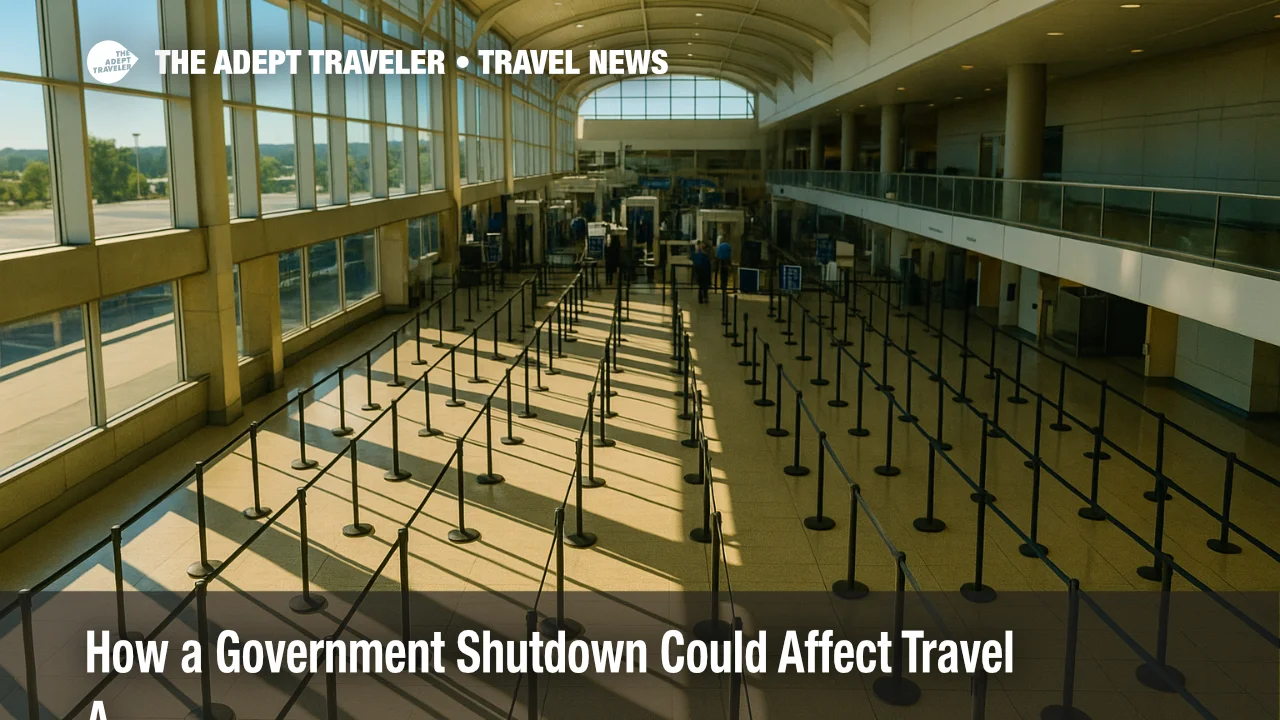How a government shutdown could affect travel

A federal funding lapse remains possible on October 1, 2025. If Congress misses the deadline, core aviation and border functions will continue, but many supporting services will pause or slow. Travelers should plan for longer airport security lines, potential flight delays tied to staffing strain, scaled-back federal customer services, and partial closures across public lands. Passport and visa work funded by fees may continue unevenly. Expect uneven park access and limited ranger services until funding resumes.
Key points
- Why it matters: A shutdown risks slower screening, delays, and limited traveler services.
- Travel impact: TSA and air traffic control continue unpaid; training and many FAA programs pause.
- What's next: If a deal slips past October 1, agencies shift to contingency plans within hours.
- Passport and visa work may proceed where fee funding and access allow, but with delays.
- National parks could restrict access or close sites with limited on-site services.
Snapshot
Airports will stay open, and Transportation Security Administration officers and air traffic controllers are "excepted" and must work without pay. That kept planes moving during past lapses, but absenteeism and fatigue grew, which slowed checkpoints and operations. FAA hiring, training, certain inspections, and modernization work would pause, compounding existing controller shortages. At the State Department, fee-funded passport and visa services can continue, yet some locations may curtail hours or close if they rely on shuttered federal facilities. At the border, U.S. Customs and Border Protection remains on duty, though non-essential customer services can scale back. National Park Service units could restrict access or close areas where basic protection and sanitation cannot be maintained.
Background
The Office of Management and Budget requires each agency to publish a shutdown, or "lapse in appropriations," plan. DHS plans keep aviation security, CBP operations, and the Federal Air Marshal Service running; DOT plans keep the National Airspace System operating while pausing hiring and training. OPM guidance confirms excepted employees work without pay until back pay is authorized. The State Department's lapse guidance explains consular operations funded by fees may proceed where practicable. For public lands, the National Park Service's March 2024 contingency plan allows directors to restrict access or close areas if they cannot be protected and kept sanitary, and outside funding from states may keep select parks open at limited levels. Industry groups warn prolonged lapses cause backlogs that outlast the shutdown itself.
Latest developments
Government shutdown travel impacts: TSA lines, FAA slowdowns, and parks access
Aviation groups and major U.S. airlines warn a funding lapse would worsen controller shortages and halt FAA hiring and training, increasing the risk of ground delays and longer queues at hub airports. DOT's consolidated lapse plan says air traffic control, essential safety work, and airport inspections continue, but rulemaking, NextGen development, and many non-urgent activities stop. OPM's updated instructions reiterate excepted employees may not be paid during the lapse, a key driver of absenteeism seen in the 2018-2019 shutdown. The State Department notes passport and visa services funded by fees can continue, but facility access and staffing constraints could slow appointments. NPCA and former park superintendents urge full park closures if staffing is insufficient to protect resources; the NPS plan empowers local restrictions or closures as needed. Travelers should monitor airline advisories and prepare for limited federal customer service channels while contingency staffing is in effect.
Analysis
The near-term risk to travelers is friction, not paralysis. Flights will operate, yet the combination of unpaid excepted workforces and paused support functions is a proven recipe for slowdowns. FAA training interruptions are the highest-leverage risk because the controller shortage is already acute; even a short halt sets training pipelines back weeks. Expect ripple effects to concentrate at chronically constrained airspace like the Northeast corridor, where minor staffing dips translate into miles-in-trail programs, ground delays, and thinned arrival rates. TSA throughput should hold, but longer lines are likely at peak hours if sick calls rise. Consular services are the classic "it depends": fee-funded does not mean disruption-free, since access to federal buildings, overtime, and ancillary support may be limited. On public lands, inconsistent local decisions can confuse travelers; assume reduced services and bring water, trash bags, and a plan B. Practical mitigation: book earlier flights, arrive at airports 30 minutes earlier than usual at peaks, enroll in expedited screening, and keep itineraries flexible.
Final thoughts
If a shutdown begins on October 1, 2025, core aviation and border security will continue, but travelers should expect slower lines, potential delays, and scaled-back services at parks and consular posts. Build buffer time into airport and connection plans, verify passport or visa appointments in advance, and check park unit alerts the day before you go. Until funding resumes, contingency operations prioritize safety over speed. Staying flexible is the best defense against government shutdown travel impacts.
Sources
- DOT operations during a lapse in annual appropriations, U.S. DOT
- DHS: Procedures relating to a lapse in appropriations (Mar. 3, 2025), DHS
- Lapse in funding for DHS, DHS
- Special instructions for agencies during a lapse starting Oct. 1, 2025, OPM
- Updated guidance on operations during a lapse in appropriations, U.S. Department of State
- National Park Service contingency plan (March 2024), U.S. DOI/NPS
- Airlines warn shutdown may slow flights, Reuters
- How a potential shutdown would impact travel, ABC News
- $1 billion lost every week: Impact of a government shutdown, U.S. Travel Association
